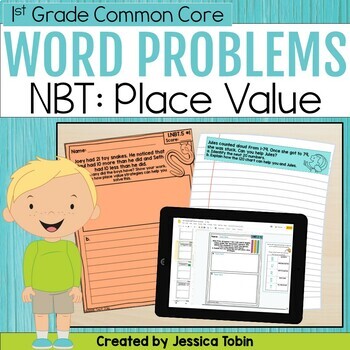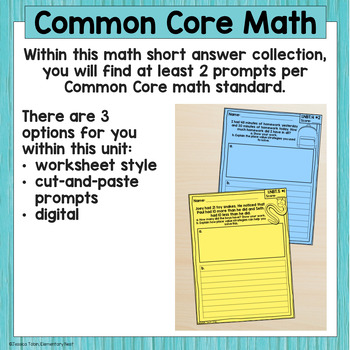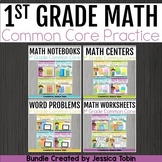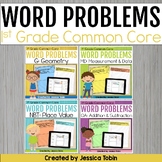1st Grade Math Word Problems NBT and Place Value - Short Answer Response
- PDF
- Google Apps™

Also included in
- This is a common core aligned math bundle for 1st grade. There are four bundles included: worksheets, centers, short answer or word problems, and interactive notebook templates. Each packet included standard-specific activities. There are centers, printables, short answer, and interactive notebook tPrice $64.00Original Price $91.00Save $27.00
- This math word problems bundle is a short answer response 1st grade practice resource to use when teaching common core math! This is not a curriculum, but a resource to help supplement your lessons! There are between 2 and 5 short answers PER standard to practice towards the end of a unit or beforePrice $14.00Original Price $18.00Save $4.00
Description
This 1st grade math word problems pack covers the Numbers and Operations in Base Ten standards, which are all about place value! There are short answer questions for topics such as counting to 120, comparing numbers, ten more and ten less, adding 2-digit numbers, subtracting tens, and more! This is perfect to use when teaching students how to answer constructed response questions (which is great for test prep or simply teaching students how to write about their math and understanding).
In this pack, you are able to choose the format that you would like to use for your students.
- traditional worksheets
- cut-and-glue strips for a notebook
- digital slides (Google)
This item aligns with the Common Core standards for the Numbers and Operations in Base Ten (NBT) domain, but you don't have to be a Common Core classroom to use this pack!
Numbers and Operations in Base Ten Topics Covered:
- Writing to 120
- Counting to 120
- 120 Charts
- Teen Numbers
- Place Values Tens and Ones
- Comparing 2-Digit Numbers
- Adding 2-Digit to 1-Digit Numbers
- Adding 2-Digit Numbers to Decade Numbers
- Adding 2-Digit Numbers to 100
- Mental Math (10 More, 10 Less)
- Subtracting Multiples of Ten
There is also a word problem strategy page at the beginning. One is a poster to print and keep in your classroom. The other are small bookmarks for students to hold onto while they are learning.
This item is included in a money-saving word problem short answer bundle.
You can also save even MORE money by buying this pack within the First Grade Common Core Math Mega Bundle!
Not interested in buying bundles? But still want 1st grade NBT products?
- Click here for NBT printables.
- Click here for NBT centers.
- Click here for NBT interactive notebook activities.
This purchase is for one single classroom only.
If you're interested in sharing with other classrooms, make sure to buy the extra licenses for a discount through the TeachersPayTeachers tool. If you are interested in a site license, please contact me for a quote at jessica.L.tobin@gmail.com.
Like this resource? Make sure to follow my store to keep up with brand-new products!
Standards Covered:
- CCSS.Math.Content.1.NBT.A.1 (1.NBT.1)- Count to 120, starting at any number less than 120. In this range, read and write numerals and represent a number of objects with a written numeral.
- CCSS.Math.Content.1.NBT.B.2 (1.NBT.2)- Understand that the two digits of a two-digit number represent amounts of tens and ones. Understand the following as special cases:
- CCSS.Math.Content.1.NBT.B.2.a- 10 can be thought of as a bundle of ten ones — called a "ten."
- CCSS.Math.Content.1.NBT.B.2.b- The numbers from 11 to 19 are composed of a ten and one, two, three, four, five, six, seven, eight, or nine ones.
- CCSS.Math.Content.1.NBT.B.2.c- The numbers 10, 20, 30, 40, 50, 60, 70, 80, 90 refer to one, two, three, four, five, six, seven, eight, or nine tens (and 0 ones).
- CCSS.Math.Content.1.NBT.B.3 (1.NBT.3)- Compare two two-digit numbers based on meanings of the tens and ones digits, recording the results of comparisons with the symbols >, =, and <.
- CCSS.Math.Content.1.NBT.C.4 (1.NBT.4)- Add within 100, including adding a two-digit number and a one-digit number, and adding a two-digit number and a multiple of 10, using concrete models or drawings and strategies based on place value, properties of operations, and/or the relationship between addition and subtraction; relate the strategy to a written method and explain the reasoning used. Understand that in adding two-digit numbers, one adds tens and tens, ones and ones; and sometimes it is necessary to compose a ten.
- CCSS.Math.Content.1.NBT.C.5 (1.NBT.5)- Given a two-digit number, mentally find 10 more or 10 less than the number, without having to count; explain the reasoning used.
- CCSS.Math.Content.1.NBT.C.6 (1.NBT.6)- Subtract multiples of 10 in the range 10-90 from multiples of 10 in the range 10-90 (positive or zero differences), using concrete models or drawings and strategies based on place value, properties of operations, and/or the relationship between addition and subtraction; relate the strategy to a written method and explain the reasoning used.







